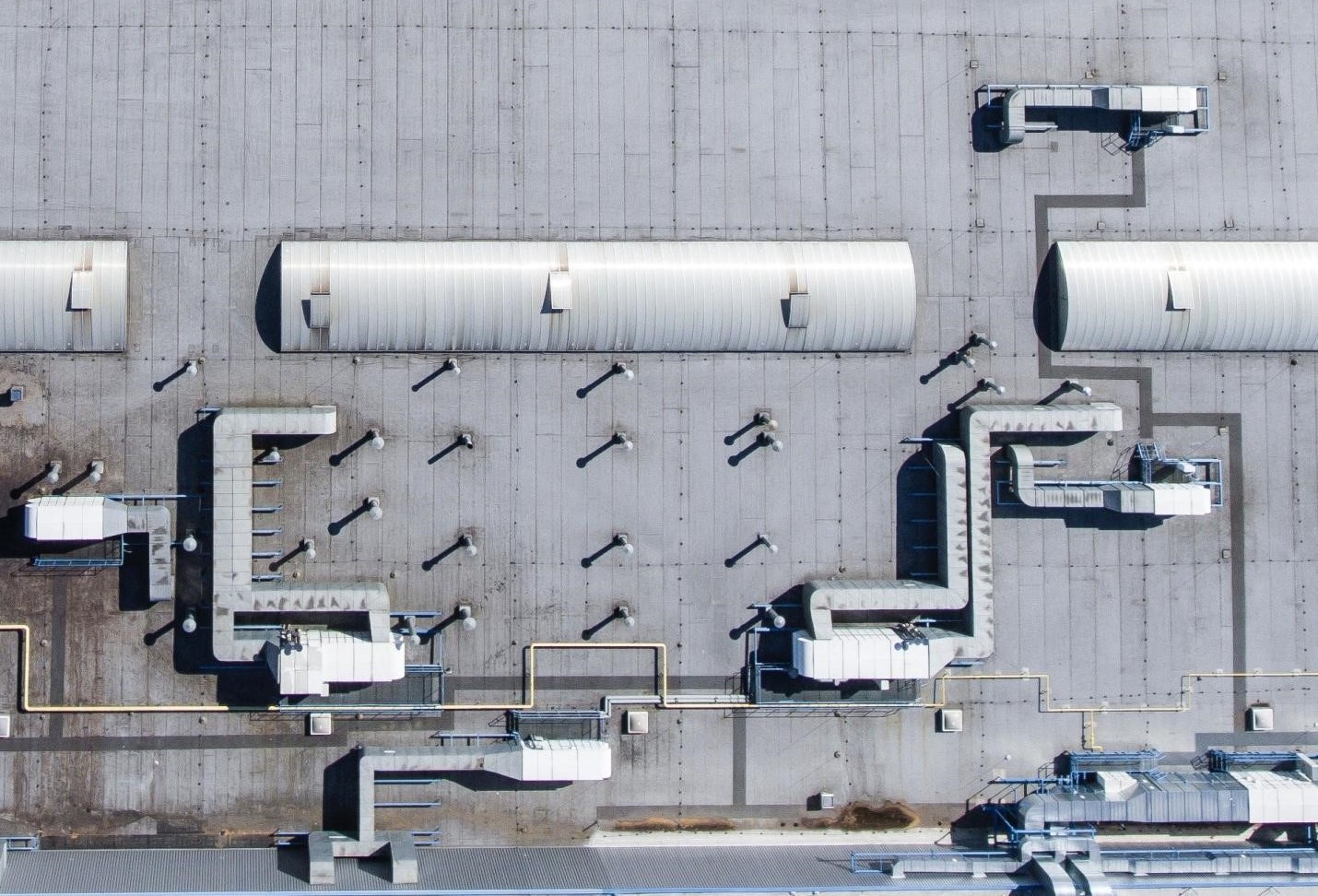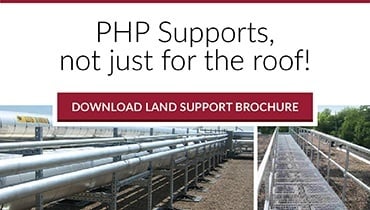The commercial and industrial roofing landscape is undergoing remarkable growth in recent years. Till 2029, the estimated market value for commercial roofing is expected to be $17.08 billion, registering a CAGR of 6.2%. At the same time, the expected market value for industrial roofing is expected to be $140.4 billion by 2033, registering a CAGR of 5.5%.
This expansion is driven by the need for advanced infrastructure and the requirement for specialized support systems that ensure the integrity, safety, and longevity of rooftops. To navigate this complex environment effectively, it is essential to understand the various roof support system components that make up these crucial frameworks.
In this article, we will discuss some critical roof support system components, their roles, and what they are made of. The goal is to help understand the elements that go into creating a safe and secure rooftop support system for essential equipment, platforms, and more.
Essential Roof Support System Components
Depending on the equipment you have, your geological location, and the weather conditions your rooftop is exposed to, the roof support system components you need will vary. However, generally, a typical system consists of the following:
1. Support Beams
Support beams are typically constructed from steel or aluminum, chosen for their excellent load-bearing capacity and durability. These beams serve as the primary load-bearing elements of the roof support system, responsible for the structural stability of the entire rooftop framework.
Support beams are designed to distribute loads and stress uniformly across the structure, ensuring its strength and resilience against external forces. The scientific principle behind support beams lies in their ability to disperse mechanical loads. By effectively transferring the weight and stress exerted on the roof to the columns and foundation below, they prevent localized strain, which can lead to structural damage over time.
2. Columns
Columns are usually made from steel or concrete due to their exceptional strength and load-bearing capabilities. In the context of roof support systems, columns are the vertical supports responsible for transferring the loads from the support beams to the foundation. They play a crucial role in ensuring structural integrity and stability.
The scientific aspect of columns centers on their capacity to withstand compressive forces. Through precise engineering and material selection, columns effectively resist axial loads, ensuring that the roof's weight is channeled safely to the foundation, preventing any structural compromise.
3. Base Plates
Base plates are commonly constructed from steel or concrete for their robustness. These plates are positioned at the bottom of columns and serve the critical function of distributing the loads onto the foundation. Base plates play a pivotal role in ensuring the stability and load-bearing capacity of the foundation.
The base plates in your roof system act as load distribution points. They disperse the weight exerted by the columns over a larger area, they reduce the pressure on the foundation, preventing soil settlement and ensuring the long-term stability of the entire roof support system.
4. Roof Decking
Roof decking materials can vary and include metal, wood, or concrete, selected based on factors like load requirements and environmental conditions. While the decking may vary based on your requirements, roof decking typically comprises the primary surface of the roof structure, providing a stable and supportive base for other roofing components. It contributes significantly to the roof's load distribution and overall stability.
The science behind roof decking is rooted in its role as a load-bearing substrate. It spreads loads evenly across the roof's surface, preventing localized stress concentrations that could lead to structural weaknesses. The choice of material is influenced by factors such as durability, weight, and corrosion resistance.
5. Roofing Membrane
Roofing membranes are typically made of bitumen, thermoplastic, rubber, or other weather-resistant materials.
The roofing membrane acts as a weatherproof layer, shielding the building from water infiltration, UV exposure, and temperature fluctuations. It is a critical component for maintaining the building's interior climate and structural integrity.
The scientific principles governing roofing membranes revolve around their impermeability and durability. These membranes are engineered to provide a continuous and robust barrier against environmental elements, ensuring that the building remains dry and free from leaks.
6. Insulation
Insulation materials include foam, mineral wool, fiberglass, or other thermally insulating substances. Insulation regulates temperature within the building by minimizing heat loss or gain. It reduces energy consumption, enhances energy efficiency, and provides comfort for occupants.
Insulation operates based on the fundamental principles of heat transfer and thermal resistance. These materials exhibit excellent thermal resistance (R-value), preventing the flow of heat, and their application helps maintain a stable indoor temperature, reducing the need for excessive heating or cooling.
7. Vapor Barrier
Vapor barriers consist of materials such as polyethylene or bitumen, designed to impede the movement of moisture. Vapor barriers prevent moisture from infiltrating the roof assembly, ensuring that the roofing structure remains free from condensation and moisture-related damage.
These barriers act as diffusion retarders. By impeding the movement of water vapor, they prevent condensation within the roofing system, which can lead to insulation degradation and structural issues.
8. Flashings
Flashings are typically made of metal, PVC, or rubber for their weather-resistant and malleable properties. Flashings are thin strips of material used to protect vulnerable areas, such as roof joints, chimneys, or penetrations, from water intrusion.
They are designed based on principles of water shedding and weatherproofing. Their installation ensures that water is effectively diverted away from sensitive areas, safeguarding against leaks and water damage.
9. Parapet Walls
Parapet walls can be constructed using masonry, metal, or other weather-resistant materials. They serve as low walls or barriers around the perimeter of the roof. They enhance safety by preventing falls, serve as windbreaks, and contribute to the aesthetics of the building.
Parapet walls are designed with principles of safety and architectural aesthetics in mind. Their height and design deter falls from the roof, and they provide additional wind resistance.
10. Roof Drains
Roof drains are typically made of plastic, cast iron, or aluminum for their corrosion-resistant properties. They are components that channel rainwater off the roof, preventing water accumulation that can cause structural damage and leaks.
Roof drains operate on principles of gravity and drainage. They create pathways for rainwater to flow efficiently off the roof, preventing pooling and water-related structural issues.
11. Scuppers
Scuppers are constructed from metal, plastic, or other water-resistant materials. They are openings or outlets that allow water to flow from the roof surface. They minimize the risk of standing water, reducing the potential for leaks and structural stress.
Scuppers also work based on gravity and drainage principles as roof drains do. They provide controlled pathways for rainwater to exit the roof, preventing the accumulation of water, which could add excessive weight to the structure.
12. Roof Hatches
Roof hatches are generally constructed from metal or aluminum for their durability and weather resistance. They are the access points for maintenance, inspections, and equipment installation on the roof.
The science behind roof hatches involves structural engineering and safety measures. These components are designed to withstand various loads while providing secure access to the roof's surface.
13. Equipment Supports
Equipment supports are usually constructed from steel or aluminum for their load-bearing capacity and durability. These supports serve as frameworks for mounting HVAC systems, pipes, and other rooftop equipment. They ensure the stability of the equipment and proper routing.
They employ load-bearing and structural engineering to support anything you'd like to place on your rooftop. These supports are engineered to bear the weight of heavy equipment while safeguarding the structural integrity of the roof.
14. Safety Rails
Safety rails are typically made of steel or aluminum for their strength and durability. These are guardrails that provide fall protection for maintenance personnel, ensuring workplace safety. Safety rails are designed based on safety engineering principles. They offer protection against falls and ensure the safety of personnel working on the roof.
These rails also serve as an OSHA-compliance addition to your roof support system.
15. Walkways
Walkways can be constructed from grating or metal surfaces for durability and corrosion resistance. Walkways are pathways on the roof that facilitate safe access for maintenance personnel while protecting the roofing material from damage.
They are designed with materials and layouts that ensure the safety of workers and protect the roof's surface from excessive wear and tear.
16. Ladders & Stairs
Ladders and stairs for rooftops are typically made of steel, aluminum, or fiberglass for their load-bearing capacity and durability. These components provide access points for reaching the roof or different roof levels safely.
17. Lightning Protection
Lightning protection systems consist of copper or aluminum conductors for their excellent electrical conductivity. These systems divert lightning strikes safely to the ground, protecting the building and its occupants from lightning-related damage. This component employs the principles of electrical conductivity to keep your staff and equipment safe. It routes lightning strikes to the ground, preventing electrical damage.
18. Cable Trays
Cable trays are generally constructed from steel or aluminum for their load-bearing capacity and electrical conductivity. They serve as supports for cables and conduits that run on the rooftop, organizing and protecting electrical systems. Cable trays ensure the effective routing of electrical systems while safeguarding personnel.
19. Duct Supports
Duct supports are typically made of steel or aluminum for their load-bearing capacity and resistance to environmental conditions. They serve as frameworks for holding HVAC and ventilation ducts in place, ensuring proper airflow and functionality. They, too, employ the load-bearing principle, blending it with functional engineering to guarantee the stability and efficient operation of duct systems.
20. Pipe Supports
Pipe supports can be constructed from steel, aluminum, or specialized materials based on the specific requirements of the pipe. These supports are designed to ensure the stability of pipes, their proper routing, and the integrity of the building's infrastructure.
By comprehending the scientific and material elements of each of these components, one can grasp their vital roles in constructing a robust and reliable roof support system. PHP Systems/Design leverages this knowledge to create tailored support systems that prioritize safety, sustainability, and enduring results.
How PHP Systems/Design Creates Bespoke Roof Support Systems
For organizations seeking customized roof support systems for pipes, ducts, equipment, or other specific requirements, PHP Systems/Design is here to help. We are a rooftop support solution manufacturer and design, helping you ensure longevity for your equipment and rooftops. Our solutions are also geared towards heightened compliance and safety for your workers, be it for the industrial or commercial sector..
Whether you require support for extreme temperature conditions, corrosion protection, or advanced solutions to enhance the performance of your roof, PHP Systems/Design is here to help. Contact us today to request pricing or call to discuss your project further, and let our team of experts provide you with the ideal roof support solution.
Conclusion
Deciphering the components of roof support systems is a critical step in understanding the intricacies of industrial roofing. These components work in harmony to ensure the safety, longevity, and efficiency of roofing structures.
As the industrial roofing industry continues to evolve, with a significant market value projected for the near future, it's essential to stay informed about the science and elements behind these crucial components. By doing so, we can contribute to the continued excellence of roofing systems in an ever-changing landscape. To learn more about the specific components for your rooftop, give us a call or request a pricing for your project!



